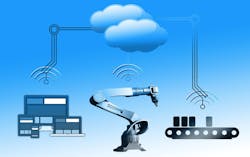1. Pushing it to the Edge
The evolution of computing and cost efficiency has made commercial devices capable of running full-on operating systems and complex algorithms, right in the office. IoT platforms in 2018 are continuing to push for the fastest connectivity. That's of course where the concept of Edge Computing comes in, where workload is processed on the edge of the network where the IoT connects the Cloud with the physical world.
A key part of this progression is the fast and effective integration between IoT and the Cloud, locating many of the processes onboard the devices themselves and connecting them with the Cloud for the most essential functions. As machine learning algorithms evolve and advance, there are a few things we can expect. One is the potential for Edge devices to take over a growing percentage of computing data. An Edge device will increase local privacy by not exporting sensitive data to the cloud.
In addition, Edge devices reduce latency from data requirements. Finally, in 2018 we will continue to see an increased momentum of companies adding business solutions requiring local, secure data analysis. Edge Computing will be a key focus of that business solution implementation due to the benefits of the Cloud’s increased security, easy scalability, design configuration, simple deployment, and management options.
IIoT is helping manufacturing to become more decentralized.
2. Blockchain Getting Hotter
While BitCoin, LiteCoin, and Ethereum had their best climb and largest drop (going back to a slow climb again in 2017), Cryptocurrency uses blockchain technology that is also likely to enter widespread adoption through increased usage cases in IoT. The fact is that every system of connected IoT devices can use blockchain to safely and reliably organize, store, and share transactions of data. Throughout this year, blockchain technology is expected to play an integral role in the widespread number of industries that manage tangible objects moving across the universe.
One prime example would be the newly-announced relationship between IBM and Nestle, Dole, and Walmart. Together, in a group of four, the companies plan to improve food safety by associating tracking values to each and every product they come in contact with, resulting in overall refinement in day-to-day health.
3. Beyond Blockchain
Of course, as more devices are connected and as IoT expands, security challenges will increase as well.
As time goes on, these challenges are bound to change as more devices are connected and the IoT community grows. Until then, experts recommend preparing for anything and everything. By staying up-to-date with the intimate, day-to-day IoT news as it develops, it is possible to learn from others’ mistakes.
More cellular and wireless options with components that need minimum power to operate are pushing more devices to the edge.
4. Expanding Platform Offerings
Designers building IoT into tangible objects and experiences need functionality for remote product management, monitoring, and controls. IoT business operators require the same. Designers need platforms with data management capabilities. These platforms will also need to produce easy-to-use business data that can be leveraged by managers, engineers, business owners, etc. As far as functionality is concerned, built-in, customizable applications will likely become the “industry standard.”
Edge processing naturally leads to consolidation. As more companies push processing and data analysis to the edge of the network in order to improve security, reduce network latency, and cut Cloud costs, it will become increasingly attractive for an IoT platform to offer additional services to distinguish itself from other enterprise offerings. The ensuing pressure of supporting both Edge and core with a cost-effective model will force all but the largest and most innovative IoT platform providers out of the market over the next few years or to focus their offering on niche applications.
5. Commercialize IoT Data
Recent European guidelines coming out recognize what 45% of data and analytics decision makers at US enterprises are saying about commercialize their data—they´re already doing it. In France, only 35% of companies are doing it, and 38% of German enterprises. Seeing the opportunity to level the playing field, the European Commission will issue guidelines this year to encourage the use of advanced data mining technology to boost the data economy with the advancement of IoT.
The IIoT is having unexpected benefits as manufacturing data is able to make better business strategies and decisions.
6. IIoT Platforms Leaving IaaS Market
A part of ongoing consolidation and offering built-in applications for customers is that the major IIoT platforms have transferred at least some of their industry-based or IoT-specific functions available through hyperscale Cloud providers like AWS, IBM, and Microsoft. As these massive Clouds extend their global reach, get clearance for compliance in a strict regulatory environment, and solidify their own IoT capabilities, this trend will continue to unfold.
Conclusions
IoT platforms have an exciting year ahead for them as they adapt to the evolving environment of edge computing, blockchain, and niche application support. The intelligent digital mesh is increasing in complexity, and the security demands at all levels of the network are here to make the year even more interesting for software designers and platform engineers alike.
Feel free to share your ideas in the comments section below. We look forward to hearing about your first-hand experiences and predictions for 2018.
Joseph Zulick is a writer and editor at MRO Electric and Supply.




